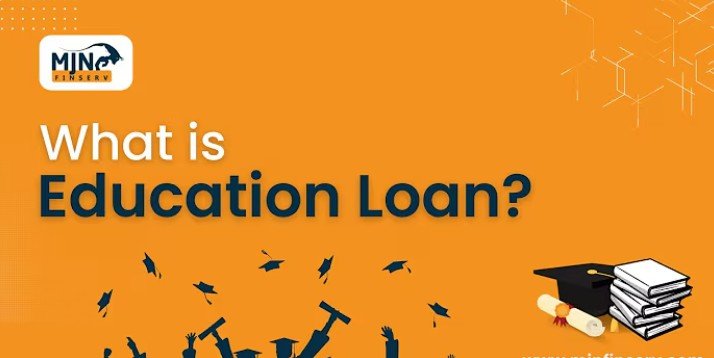Introduction
Higher education is a crucial stepping stone to career success, but the rising costs can be overwhelming. Education loans serve as a financial lifeline, helping students and their families afford tuition, books, and living expenses. Whether you are planning for college, postgraduate studies, or professional courses, understanding education loans is essential for making informed decisions.
This comprehensive guide will cover everything you need to know about education loans, including types, eligibility criteria, the application process, repayment options, and tips to manage your student debt effectively.
What is an Education Loan?
An education loan is a financial aid option that allows students to borrow money to pay for their academic expenses. The borrower agrees to repay the lender in installments, usually after completing their education, along with accrued interest.
Key Components of an Education Loan
- Principal: The original amount borrowed.
- Interest Rate: The percentage charged on the borrowed amount.
- Loan Term: The duration within which the loan must be repaid.
- Grace Period: A time frame after graduation before repayment begins.
- Repayment Plan: The structure of loan payments.
Types of Education Loans
There are several types of education loans designed to meet the financial needs of students. Understanding these can help in selecting the right loan.
1. Federal Student Loans
These loans are issued by the government and typically have lower interest rates and flexible repayment options.
- Direct Subsidized Loans: For undergraduate students with financial need; interest is paid by the government during school and grace periods.
- Direct Unsubsidized Loans: Available to undergraduate and graduate students; interest accrues from disbursement.
- Direct PLUS Loans: For graduate students and parents of undergraduates; requires a credit check.
- Perkins Loans (Discontinued): Previously offered to students with exceptional financial need.
2. Private Student Loans
Issued by banks, credit unions, and private lenders, these loans often have higher interest rates and require creditworthiness.
3. State-Sponsored Loans
Some states offer their own education loan programs with competitive interest rates.
4. Institutional Loans
Certain colleges and universities provide loans to their students as part of their financial aid programs.
5. International Student Loans
Designed for students studying abroad who do not qualify for domestic financial aid.
Education Loan Eligibility Criteria
Lenders assess various factors before approving an education loan.
1. Academic Enrollment
Students must be enrolled in an accredited institution.
2. Credit Score
Private loans often require a strong credit score or a co-signer.
3. Financial Need
Federal loans may be awarded based on demonstrated financial need.
4. Repayment Ability
Lenders evaluate future earning potential for loan approval.
The Education Loan Application Process
1. Research Loan Options
Compare interest rates, repayment terms, and benefits before choosing a loan.
2. Complete the FAFSA
The Free Application for Federal Student Aid (FAFSA) determines eligibility for federal loans and grants.
3. Apply for Loans
Submit loan applications to federal or private lenders with necessary documentation.
4. Loan Approval and Disbursement
Once approved, the loan amount is disbursed directly to the educational institution.
5. Loan Agreement and Promissory Note
Students must sign a legal agreement outlining the loan terms and repayment obligations.
Repayment Options for Education Loans
1. Standard Repayment Plan
Fixed payments over a 10-year period.
2. Income-Driven Repayment Plans
Payments are based on income and family size, with loan forgiveness after 20-25 years.
3. Graduated Repayment Plan
Payments start low and increase over time.
4. Extended Repayment Plan
Payments are spread over up to 25 years to lower monthly costs.
5. Loan Forgiveness Programs
Certain careers, such as public service or teaching, may qualify for loan forgiveness.
Tips for Managing Education Loans Effectively
- Borrow Only What You Need – Avoid overborrowing to minimize debt.
- Understand Your Repayment Terms – Be aware of due dates, interest rates, and payment options.
- Make Interest Payments Early – Reducing interest accrual lowers overall repayment costs.
- Consider Loan Consolidation – Combining multiple loans simplifies repayment.
- Explore Loan Forgiveness Options – Check eligibility for federal forgiveness programs.
Common Education Loan Mistakes to Avoid
- Not Understanding Loan Terms – Read the fine print before borrowing.
- Ignoring Interest Accrual – Unpaid interest can increase total debt.
- Delaying Payments Without Planning – Consider deferment or forbearance only when necessary.
- Skipping FAFSA – Missing out on federal aid opportunities.
- Failing to Explore Scholarships and Grants – Free financial aid should be utilized first.
Conclusion
Education loans provide critical financial support for students pursuing higher education. Whether you opt for federal, private, or institutional loans, understanding eligibility, repayment options, and best practices for debt management ensures a smooth borrowing experience. By borrowing wisely and planning for repayment, students can minimize financial stress and focus on achieving their academic and career goals.







